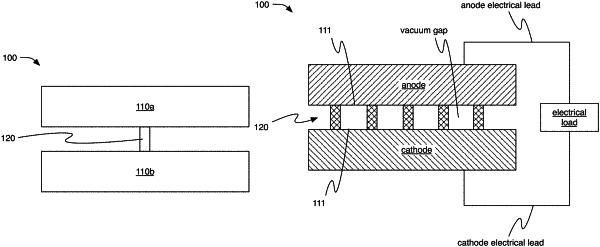| CPC H01J 45/00 (2013.01) | 20 Claims |

|
1. A thermionic energy converter system, comprising:
a first electrode comprising a first surface;
a second electrode comprising a second surface; and
a mesh spacer maintaining a gap between the first and second surfaces;
wherein:
the first and second surfaces are arranged facing each other across the gap;
the mesh spacer electrically and thermally isolates the first electrode from the second electrode;
the mesh spacer defines a mesh structure comprising a set of vertices and a set of paths connected between vertices of the set, the set of paths comprising a first path and a second path;
the mesh spacer comprises a set of legs extending substantially along the set of paths, the set of legs comprising:
a first leg extending substantially along the first path, the first leg comprising a first protrusion that contacts the first surface, the first protrusion protruding toward the first surface from a body of the first leg; and
a second leg extending substantially along the second path, the second leg connected to the first leg via the set of legs, wherein the second leg contacts the second surface; and
the mesh spacer defines a plurality of apertures between legs of the set of legs, wherein, for each aperture of the plurality, a respective first surface normal vector from the first surface to the second surface passes through the aperture and does not intersect the mesh spacer.
|